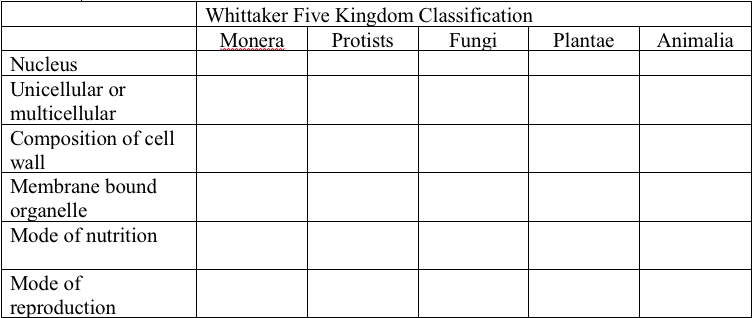Whittaker Classification is the classification of the living world into Five Kingdoms. This classification was based on cell morphology, body organization, and mode of nutrition.
Introduction to Whittaker Classification

Carolus Linnaeus had classified the living world into Two kingdoms i.e. Plants and Animals, based on their cell walls. This system did not distinguish or categorize unicellular, multicellular, prokaryotes, eukaryotes, and photosynthetic and non-photosynthetic organisms. Following are the drawbacks of the Two Kingdom classification-
- Whole living world was categorized in only two kingdom – Plant and animals
- Prokaryotes and Eukaryotes were placed together.
- No division for unicellular and multicellular organisms.
- Photosynthetic and non photosynthetic were put together.
- No distinct category for Autotrophic and Heterotrophic organisms
Need for the Five Kingdom Classification

The diverse form of life forms cannot be categorized in only these two categories. And hence this there is need for another system. Understanding this need, R.H Whittaker proposed the 5-kingdom classification hence called Whittaker Classification. This classification was based on cell morphology, body organization and mode of nutrition. He classified into 5 kingdoms as follows-
1) Monera
2) Protista
3) Mycota
4) Metaphyta
5) Metazoa
The Whittaker Classification:
Kingdom Monera:
- It includes the unicellular prokaryotic organisms.
- The members of monera lack nucleus and other membrane bound organelles.
- Their Cell wall is made of Peptidoglycan.
- They follow asexual mode of reproduction.
- Their mode of nutrition is autotrophic or heterotrophic.
- It includes Archaebacteria, Eubacteria and mycoplasma.
- Archaebacteria: They are also called as extremophiles, because they are found in extreme conditions like high temperature or salt environment. Remnant symbiotic methane producing methanogen also falls in this category.
- Eubacteria: The eubacteria contains defined and rigid cell wall. The mode of nutrition could be photosynthetic autotrophic (cyanobacteria) and heterotrophic (lactobacillus).
- Mycoplasma: They lack cell wall. They are smallest self-replication organisms. They have minimum number of organelles for their growth.
Kingdom Protista:
- It includes single cell eukaryotic organisms.
- They have nucleus and membrane bound organelle.
- Their cell wall is made up of cellulose.
- They follow both sexual and asexual mode of reproduction.
- It includes Chrysophytes, Dinoflagellates, Euglenoids, Slime Moulds and Protozoans.
- Chrysophytes: It includes golden algae and diatoms. They are aquatic and also called as planktons. The diatoms have thick cell wall with silica. The fossils of diatoms are called as diatomaceous earth.
- Dinoflagellates: They are photosynthetic and found in marine environment. As per their name, most of their members of have two flagella. They release toxins, which may harm other aquatic life forms.
- Euglenoids: They are found in fresh or stagnant water. Their mode of nutrition may be autotrophic and heterotrophic.
- Slime Moulds: They are saprophytes and eat the dead material. They play an important role in decomposing the dead material.
- Protozoans: They are heterotrophs and depend on others for their food. Based on mode of nutrition, they are further classified as amoeboid protozoans, Flagellated Prozoans, paracmacium, plasmodium, Ciliated Protozoans and Sporozoans.
Kingdom Fungi:
- They include heterotrophic organisms. This kingdom includes both useful and pathogenic organisms.
- They follow both sexual and asexual reproduction.
- Their cell wall is made of Chitin, glucan and glycoproteins.
- Their mode of nutrition varies from saprophytic to parasitic and also found in symbiotic relation.
- Based on their mode of nutrition they are further categorized as Phycomycetes, Ascomycetes, Basidiomycetes and Deuteromycetes.
Kingdom Animalia/ Metazoa:
- This kingdom includes multicellular eukaryotic animals.
- They are heterotrophic.
- The cell wall is absent.
- They have ingestive type of digestion.
- The tissue and organ system is organized.
- They follow sexual mode of reproduction.
Kingdom Metaphyta:
- It includes multicellular eukaryotic plants.
- They are autotrophs and synthesize their own food by photosynthesis.
- They contain cell walls and made of cellulose and lignin.
- Tissue system is well defined.
- They reproduce by sexual and asexual mode.
Merits of Whittaker’s Classification:
- The system was world wide accepted because its scientific approach.
- The classification was based on different characteristics like morphology, body organization and mode of nutrition that allows to categorize diverse life forms.
- The Whittaker’s classification acknowledged prokaryotes as different category based on their characteristics.
- The classification identified that unicellular eukaryotes are different from multicellular eukaryotes and offered separate kingdom as Protista.
- A separate kingdom for fungi justifies its difference from prokaryotes and eukaryotes.
When Whittaker classified the life forms, virus were not discovered and hence so information about virus is included. The microscopic studies were not much developed due to which Whittaker classification failed to distinguish the lower life forms.
Activity for Whittaker Classification:
For better understanding, perform the below activity. In the given empty box, summarize the characteristics of all the five kingdoms.

If you liked this resource, please Like, Share, and Subscribe us for more content.


